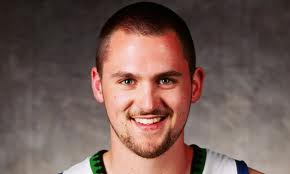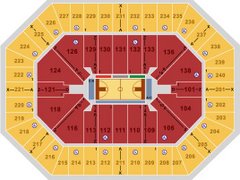I am not the biggest college basketball fan. I don’t watch every game like I (try) to do with the NBA. Whereas I can name you 20 NBA players off the top of my head in a matter of minutes, I would struggle to do the same with college players. Sure, I’d get the big ones like Wiggins, Parker and Embiid – but that’s about it. So for many of these rookie profiles pieces, I am just now introducing myself to the player. And by ‘introducing myself to the player’, I mean spending a couple hours reading articles and watching videos highlights. So when I began my research on Adreian Payne and my first glimpse of his was this:
I was all like this:
And then when I found out he can shoot the three and was a 6-10 stretch four with a 7-4 wingspan, my mind was blown. Soon, I quickly realized my heart was set on Payne. I even drafted a closing to this article that read: “GIVE HIM TO ME. I WANT ADREIAN PAYNE ON THE T-WOLVES. HE WILL BE THE FUTURE FOUR WE NEED. MY HEART DOESN'T NEED LOVE WHEN ALL IT WANTS IS PAYNE."
But then the part of the research where I read articles and scouting reports began. And the more I read, the less and less enthusiastic I became. Suddenly, Payne wasn’t so appealing. No longer was I drooling like my dog watching me eat a hamburger. Before, I really wanted him. Now “I-don’t-really-want-him-but-if-we-got-him-I’d-understand-that-said-I-wouldn’t-be-thrilled-about-it-but-hopefully-I’d-be-incorrect-in-my-analysis-of-him-and-Payne-would-prove-me-wrong-by-being-good.”
Strengths
The kid does have game. What I love about him is that he’s pretty good at the two most efficient shots in basketball (dunks and threes). You already know about his dunking ability, but his three point shooting, while not as impressive, is more than solid. In his first two college seasons at Michigan State, Payne attempted only three 3-pointers. In his junior season he shot a total of 42, hitting 16 treys. He upped that again during his senior year, taking 104 threes and hitting 44 of them. Combine the two seasons in which he started attempting at least one three point shot a game, and Payne is a career 41.2% three point shooter. That should translate into him being a solid three pointer in the NBA (Though let me be clear: if he shoots any where close to 40% from three in the NBA, this kid will be more than a solid three point shooter).
That said, what makes Payne special is that he can score efficiently in a variety of ways. From Draft Express on his senior year shooting efficiency and versatile scoring ability:
“His 61% TS% (true shooting percentage = a measure of shooting efficiency that takes into account field goals, 3-point field goals, and free throws) ranked 13th overall among Top-100 prospects, and he was utilized in an incredibly wide variety of ways this season, be it posting up, running the floor (or trailing) in transition, finishing as a roll-man or cutter around the basket, spotting up and knocking down open jumpers on the perimeter, or attacking closeouts with strong takes to the basket or a pump-fake and one-dribble pull-up.”While I already touched on his ability to shoot the three, I have yet to talk about his ability to finish at the rim (at least outside of dunking). And according to Draft Express, he was also good at that. Here is a direct quote:
“(He) ranked as one of the best ‘around the basket’ finishers in college basketball in the half-court. Payne converted an outstanding 70% of his attempts in these situations, thanks to his big hands, long arms and explosive leaping ability.”As you can tell, Payne was a really good offensive player in college. And if even half of his abilities can decently translate to the faster paced game that is the NBA, he will be a solid player in the league. Now, if more than half translates, who knows how good he could be. That said, there are weaknesses in his game that may prevent his abilities from translating at all. And that is why, as I explained in the opening, my opinion of him has changed so dramatically.
(Couldn’t fit this anywhere, but it should be noted that he’s a high character guy. No, like, he’s seriously a good dude. Read this and it will make your day and make you believe there is still good in the world. RIP Lacey Holsworth).
Weaknesses
I worry about whether or not his shot will translate well. While his form is consistent, due to a big dip he has in his gather, his release is slow. Obviously if he has time to get his feet set Payne is fine, but considering he played in the Big 10 (not exactly the most fast paced basketball conference in the NCAA), I do have my concerns about his shot being effective in the faster paced NBA.
Also, given his physical gifts (being 6-10, having a 7-4 wingspan and a freakish leaping ability) one would think he would dominate the boards. Yet, instead, he doesn’t. In fact, his defensive rebounding percentage ranked behind Kyle ‘Slo-Mo’ Anderson – a player whose nickname is based on the fact he is unathletic.
But why is that? Why is someone like Payne not dominating boards? Because of the two following MAJOR ISSUES:
1. He has, according to draft express, a very weak lower body
2. He has smaller lungs than the average person his size.
These are two major issues because you need lower body strength to box people out and establish position. Also you need effort and stamina to rebound. And if you have small lungs, you physically can’t exert as much effort as someone of the same body type with regular sized lungs, because if you do, you will get tired quicker, and therefore you will lose stamina – which you need to rebound consistently throughout the game – quicker than your opponent.
Another weakness in his game is that, despite playing four years of college ball and gaining all that experience, he still lacks defensive awareness. From Bright Side Of The Sun:
“His understanding of and feel for the game on the defensive end isn't where it needs to be. He can get turned around, lose his man, fail to make the right rotation and end up just lost at times defensively.”All rookies have their weaknesses - even top five picks. But at 23 years old, to have this many weaknesses in your game is a tad disconcerting. A GM wonders, how much room does a 23 year old rookie have to grow? What’s his potential? If Payne was 19 or 20, I’d be thrilled about where he is. To have already developed an outside J by then would make GM’s think, “wow, this kid has even more upside and room to grow.” But to only have just developed a solid three at the age of 23, you wonder how much is left. What upside does a 23-year-old rookie with weaknesses you wouldn’t think a four-year college player would be linked to (i.e. defensive awareness issues) have? That’s the gamble you’re taking with Payne. That said, drafting an older rookie can work. Just look at Gorgui Dieng.
Final Word
Given the types of body transformations we’ve seen with NBA players (Kevin Love comes to mind), I think Payne’s lower body strength issue could be easily fixed over a summer of strength training with an NBA level trainer. So could the dip in his shot – it’s not like his shot needs massive reconstruction surgery. The issue with him is that he is 23 years old, and not 19 or 20. Because if he were a younger age and was the same player he is today, scouts would fall in love with him and he probably wouldn’t even be available with the 13th pick. But instead, thanks to his age, here we are thinking the Timberwolves may select Adreian Payne.
I wouldn’t be as thrilled with pick as I would be if we were to take Kyle Anderson, but, that said, I’d understand the pick. Payne, if he can improve upon his lower body strength, could be a steal in the NBA draft. I just wonder why, at the age of 23 and having spent the last four years in college, he still lacks lower body strength. Did they not have a strength program at Michigan State? Did the Spartans training facility have a busted leg press? I would like to know!
Having already taken a look at draftees playing the position of PG (Tyler Ennis), SF (Kyle Anderson) and just now PF, it is time to next take a look at the position of SG. And continuing with the theme if taking a look at Michigan State Spartans, the next player getting a draft profile is Garry Harris, who, if the T-wolves are lucky, will fall to them on draft night.

.gif)






No comments:
Post a Comment